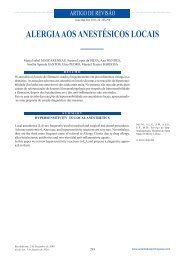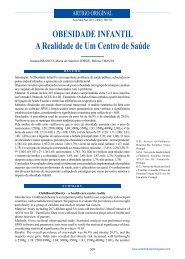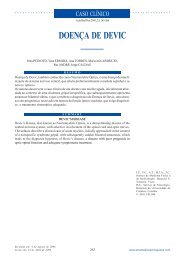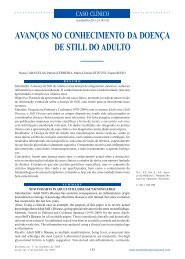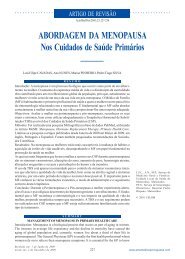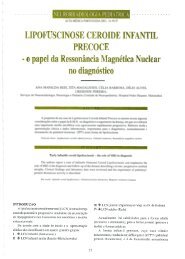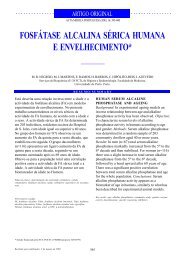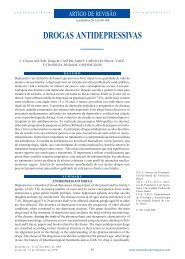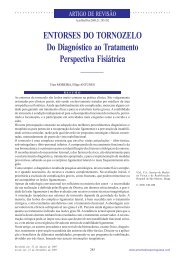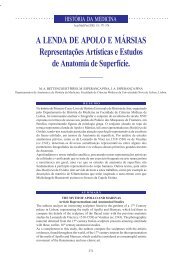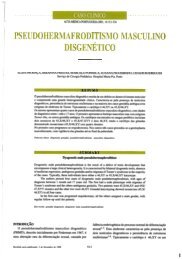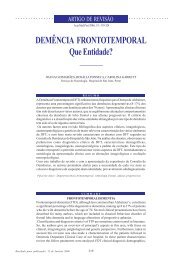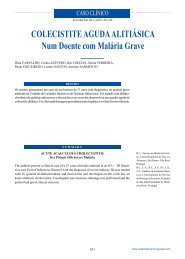DIAGNÓSTICO E TRATAMENTO DO NÓDULO SOLITÁRIO DA ...
DIAGNÓSTICO E TRATAMENTO DO NÓDULO SOLITÁRIO DA ...
DIAGNÓSTICO E TRATAMENTO DO NÓDULO SOLITÁRIO DA ...
Create successful ePaper yourself
Turn your PDF publications into a flip-book with our unique Google optimized e-Paper software.
HELENA VILAR et al<br />
INTRODUÇÃO<br />
S U M M A R Y<br />
Diagnosis and Treatment of Solitary thyroid nodule – Study and Evaluation in Portugal<br />
Introduction – The best diagnostic and treatment strategy for an approach to the<br />
nodular thyroid disease continues to be a controversial issue.<br />
Objectives – The aim of this study was to characterise medical practice in the diagnosis<br />
and treatment of nodular thyroid disease by endocrinologists and surgeons in Portugal<br />
in 2002.<br />
Methods – A questionnaire based on that used by the European Thyroid Association<br />
and the American Thyroid Association was drawn up. The questionnaire, based on a<br />
well-defined index case, was circulated by the Portuguese Endocrinology Society to<br />
endocrinologists and surgeons: 42 year-old woman with solitary thyroid nodule<br />
measuring 2 x 3 cm, with no history of malfunction or painful symptoms. Each doctor<br />
was asked to reply as to the adopted diagnosis and therapy procedures for the index<br />
case. Eleven variations to the original case were proposed in order to evaluate the<br />
alterations for each variation.<br />
Results – 1492 questionnaires were sent out, 163 to endocrinologists and 1329 to<br />
surgeons. A total of 104 were returned. The global response rate was 7%. The response<br />
rate for endocrinologists was 27% and 4.5% for surgeons. Of the 104 questionnaires<br />
returned, 42% were from endocrinologists and 58% from surgeons.<br />
Concerning tests prescribed, surgeons would use more tests than endocrinologists for<br />
the index case. The main differences in laboratory terms were the higher number of<br />
prescriptions for total T4 and T3 and thyroglobulin by surgeons and more prescriptions<br />
for AATPO by endocrinologists.<br />
The average number of tests was 4.6, 4.1 for endocrinologists and 5.1 for surgeons.<br />
Relative to imaging and cytology, 32% of doctors advocated a scintigraphy to diagnose<br />
the index case, with no significant differences between endocrinologists and surgeons.<br />
Ultrasonography was used by over 85% of respondents. 90% prescribed a cytology,<br />
83% guided by palpation and 18% ultrasonography-guided.<br />
Concerning treatment, 33% of doctors advocated levothyroxin treatment; surgery was<br />
advocated by 16.3% of endocrinologists and 36.6% of surgeons. Meanwhile, the majority<br />
of doctors (68%) would opt for no treatment and simply maintain the patient under<br />
surveillance.<br />
Conclusions – There are important differences in the approach to nodular thyroid<br />
disease among the various doctors and specialists, which highlight the difficulty in<br />
achieving a diagnostic and therapeutic consensus.<br />
Key-words: thyroid nodule, diagnosis, treatment<br />
A patologia nodular da tiroideia é um achado frequente<br />
nas consultas de Endocrinologia. Estudos epidemiológicos<br />
efectuados nos Estados Unidos da América, apresentam<br />
uma prevalência de 4 a 7% de nódulos detectados<br />
por palpação 1 . No entanto, em séries em que a prevalência<br />
foi estudada por ecografia, esta aumentou para cerca de<br />
30% 2 , sendo ainda maior nos estudos efectuados em autópsias<br />
(50%) 3 . Apesar da frequência encontrada, a presença<br />
de malignidade surge em menos de 5% dos casos 3,4 .<br />
A referenciação precoce dos doentes com nódulos<br />
tiroideus suspeitos à Endocrinologia, parece resultar numa<br />
404<br />
poupança de recursos financeiros e de tempo dispendido,<br />
assim como num aumento da precisão diagnóstica 5 .<br />
No entanto, muitos especialistas não estão ainda de<br />
acordo com o valor preditivo de factores clínicos suspeitos,<br />
dos meios auxiliares de diagnóstico a utilizar, ou sobre<br />
os critérios de escolha para as melhores opções terapêuticas<br />
6,7 . Recentemente, inquéritos europeu e norte-<br />
-americano sobre o diagnóstico e tratamento do nódulo<br />
tiroideu, revelaram a discrepância existente entre os vários<br />
tiroidologistas, na forma de actuação e tratamento desta<br />
patologia 8,9 .<br />
Ao termos em conta a prevalência da doença nodular<br />
da tiroideia e simultaneamente o número de tiroidologistas



